Numerical Simulation of Vortex-Induced Vibration of TTR and SCR
Abstract
:1. Introduction
2. Numerical Method
2.1. Governing Equation
2.2. Geometric Model and Mesh Generation
2.3. Boundary Condition
- a.
- Velocity inlet boundary condition;
- b.
- Pressure outlet boundary condition;
- c.
- Symmetric boundary condition;
- d.
- Wall boundary condition.
- a.
- Velocity inlet boundary condition:The random composition at the inlet was set in a mainstream way, such that, at the inlet, there were
- b.
- Pressure outlet boundary condition:The outlet position was set as the pressure outlet and the boundary condition at the pressure outlet position set as static pressure changing with depth, such that there waswhere is the water depth, is the density, and g is the acceleration of gravity. As the coordinate origin was taken at the position of the water surface, the water depth was a negative value. Similarly, the random composition at the outlet was set in a mainstream way.
- c.
- Symmetry condition:
- d.
- Wall boundary condition:In the calculations, the walls were all nonslip wall boundary conditions, the influence caused by the roughness of the riser outer surface ignored, and the riser considered to be a hydraulically smooth pipe, such that there was
2.4. Other Control Parameters
- The calculation used an implicit solution method based on pressure.
- At the same time, a second-order implicit transient calculation model (unsteady) was used.
- Coupling of pressure and velocity adopted the calculation method of pressure-implicit with splitting of operators.
- For discretization of the pressure term, the discrete scheme dominated by the volume force was adopted.
- For discretization of the momentum equation, the discrete scheme of boundary position central difference was adopted [23].
- The calculated time step was 0.0001 s.
- In the calculations, when extracting the lift and drag coefficients, the reference area used was the projected one-time area of diameter and height, expressed as .
3. Calculation Results and Analysis
3.1. TTR Calculation Results
3.2. SCR Calculation Results
3.3. Results Analysis
- With the passage of depth and time, the vortex mode of the VIVs generated by the riser remained unchanged;
- The period of the lift coefficient of the VIVs was about twice that of the drag coefficient;
- With changes in depth, the amplitude of the lift and drag coefficients changed;
- With changes in depth, the vibration phase of the lift and drag coefficients changed.
- With changes in depth, the vibration period of the drag and lift coefficients of the SCR changed and the value of the TTR remained unchanged. This was due to the lift and drag coefficients being respectively proportional to the lift and drag and inversely proportional to the frontal area of the riser section. The frontal area of the SCR section changes with depth, so the vibration period of the drag and lift coefficients of the SCR changed and the value of the TTR remained unchanged with depth;
- The vibration period of the lift coefficient of the SCR was close to twice the vibration period of the drag coefficient, but there was a deviation. However, the vibration period of the TTR lift coefficient was twice the vibration period of the drag coefficient. Similarly, the change of the frontal area of the riser section resulted in the difference between the TTR and SCR;
- With changes in depth, the drag and lift coefficients of the part near the water surface in the SCR were the largest and the lift and drag coefficients of the middle section in the TTR the largest. Since the frontal area of the SCR near the water surface was the smallest, the drag and lift coefficients here were the largest. After the deformation of the TTR, the frontal area of the middle section was the smallest, so the drag and lift coefficients were the largest here. This observation has practical significance for effectively controlling the VIVs of riser. Dampers can be installed in the middle section of the TTR and the part of the SCR close to the water surface, so as to usefully reduce the intensity of the VIVs.
4. Conclusions
- Under the same water depth, the vibration period of the lift and drag coefficients of the TTR was about twice that of the SCR;
- The lift coefficient vibration period of the SCR was close to twice that of the drag coefficient vibration period and the lift coefficient vibration period of the TTR twice that of the drag coefficient vibration period;
- With increased water depth, the lift and drag coefficients of the SCR decreased;
- The lift and drag coefficients of the TTR changed little with water depth, and the lift and drag coefficients were the largest in the middle section;
- The modes of vortices generated by the SCR and TTR at this Reynolds number (Re, 4000) did not change with depth and time.
Author Contributions
Funding
Institutional Review Board Statement
Informed Consent Statement
Data Availability Statement
Conflicts of Interest
References
- Chaplin, J.R.; Bearman, P.W.; Cheng, Y.; Fontaine, E.; Willden, R. Blind predictions of laboratory measurements of vortex-induced vibrations of a tension riser. J. Fluids Struct. 2005, 21, 25–40. [Google Scholar] [CrossRef]
- Wang, C.; Wang, Y.; Liu, Y.; Li, P.; Wang, F. Experimental and numerical simulation investigation on vortex-induced vibration test system based on bare fiber Bragg grating sensor technology for vertical riser. Int. J. Nav. Archit. Ocean Eng. 2021, 13, 223–235. [Google Scholar] [CrossRef]
- Duggal, A.S.; Niedzwecki, J.M. Estimation of flexible cylinder displacements in wave-basin experiments. Exp. Mech. 1995, 35, 233–244. [Google Scholar] [CrossRef]
- Chaplin, J.R.; Bearman, P.W.; Huarte, F.; Pattenden, R.J. Laboratory measurements of vortex-induced vibrations of a vertical tension riser in a stepped current. J. Fluids Struct. 2005, 21, 3–24. [Google Scholar] [CrossRef]
- Baarholm, R.; Kristiansen, T.; Lie, H.; Herfjord, K. Experimental investigation of dual riser interaction. In Proceedings of the 24th International Conference on Offshore Mechanics and Arctic Engineering (OMAE2005), Halkidiki, Greece, 12–17 June 2005; Volume 1. [Google Scholar]
- Trim, A.D.; Braaten, H.; Lie, H.; Tognarelli, M.A. Experimental investigation of vortex-induced vibration of long marine risers. J. Fluids Struct. 2005, 21, 335–361. [Google Scholar] [CrossRef]
- Zhang, Y.; Meng, F.; Guo, H. Experimental Investigation of Vortex-Induced Vibration Responses of Tension Riser Transporting Fluid. In Proceedings of the Asme International Conference on Ocean, Honolulu, HI, USA, 31 May–5 June 2009. [Google Scholar]
- Sun, Y. Numerical prediction of fatigue damage in steel catenary riser due to vortex-induced vibration. J. Hydrodyn. Ser. B 2011, 23, 154–163. [Google Scholar]
- Wang, E.; Xiao, Q. Numerical simulation of vortex-induced vibration of a vertical riser in uniform and linearly sheared currents. Ocean Eng. 2016, 121, 492–515. [Google Scholar] [CrossRef] [Green Version]
- Yu, D.; Lu, Z.; Wan, D.C. Numerical simulations of vortex-induced vibrations of a flexible riser with different aspect ratiosin uniform and shear currents. J. Hydrodyn. Ser. B 2017, 29, 1010–1022. [Google Scholar]
- Lin, K.; Wang, J. Numerical simulation of vortex-induced vibration of long flexible risers using a SDVM-FEM coupled method. Ocean Eng. 2019, 172, 468–486. [Google Scholar] [CrossRef]
- Numerical Study of the Fluid-Structure Interaction During CNT-Water Nanofluid Mixed Convection in a Micro-Channel Equipped with Elastic Fins Under Periodic Inlet Velocity Conditions. Exp. Tech. 2021, 1–9. [CrossRef]
- Badhurshah, R.; Bhardwaj, R.; Bhattacharya, A. Numerical Simulation of Vortex-Induced Vibration With Bistable Springs: Consistency with the Equilibrium Constraint. J. Fluids Struct. 2021, 103, 103280. [Google Scholar] [CrossRef]
- Xie, W.; Xin, W.; Zhang, H. Influence of the internal varying density flow on the vibrations and fatigue damage of a top-tensioned riser undergoing vortex-induced vibrations. Appl. Ocean Res. 2021, 117, 102955. [Google Scholar] [CrossRef]
- Zhao, G.X.; Gui, H.B.; Hu, J. Numerical simulation of flow around finite-length wavy cylinders. J. Harbin Eng. Univ. 2021, 53, 163–170. [Google Scholar]
- Deardorff, J.W. The Use of Subgrid Transport Equations in a Three-Dimensional Model of Atmospheric Turbulence. J. Fluids Eng. 1973, 95, 429. [Google Scholar] [CrossRef]
- Qiao, Y.L.; Gui, H.B.; Liu, X.X. Analysis of three-dimensional numerical simulation methods for turbulent flow past circular cylinder. Hydro-Sci. Eng. 2016, 3, 119–125. [Google Scholar]
- Leonard, A. Energy Cascade in Large Eddy Simulations of Turbulent Fluid Flow. Adv. Geophys. 1974, 18 Pt A, 237–248. [Google Scholar]
- Guo, C.Y.; Guo, H.; Hu, J. Large eddy simulation of flow characteristics around a twisted cylinder. J. Harbin Eng. Univ. 2021, 42, 331–338. [Google Scholar]
- Poje, A.C.; Lumley, J.L. A model for large-scale structures in turbulent shear flows. J. Fluid Mech. 1995, 285, 349–369. [Google Scholar] [CrossRef]
- Favre, A. Equations des gaz turbulents compressibles, II. Méthode des vitesses moyennes: Méthode des vitesses macroscopiques pondérées par la masse volumique. J. Méc. 1965, 4, 390–421. [Google Scholar]
- Smagorinsky, J. General Circulation Experiments with the Primitive Equations: I The Basic Experiment. Mon. Weather Rev. 1962, 91, 99–164. [Google Scholar] [CrossRef]
- Leonard, B.P. The ULTIMATE conservative difference scheme applied to unsteady one-dimensional advection. Comput. Methods Appl. Mech. Eng. 1991, 88, 17–74. [Google Scholar] [CrossRef]
- Huang, W.P.; Chen, H. Study on Lift Coefficient and Drag Coefficient of Elastic Multi-riser Based on CFD. Ship Ocean Eng. 2011, 40, 94–97. [Google Scholar]
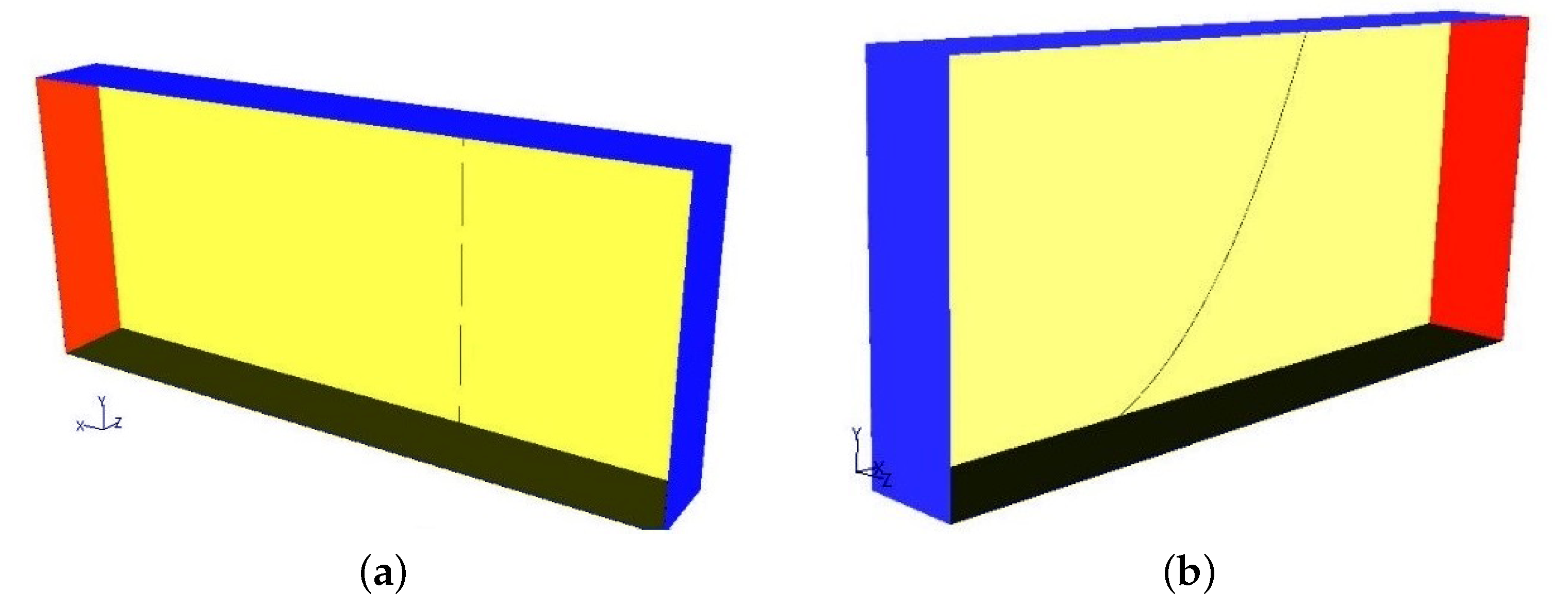
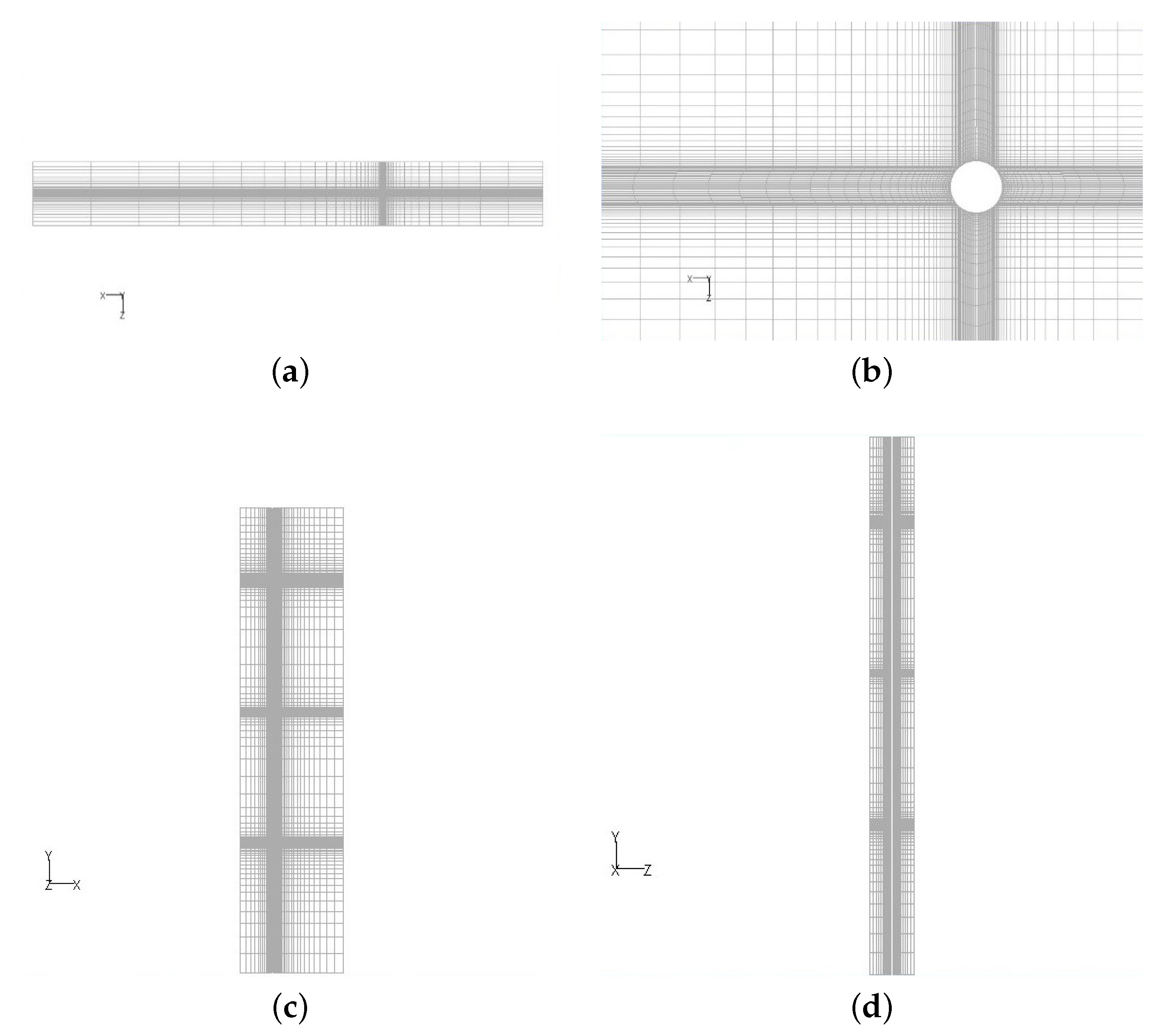
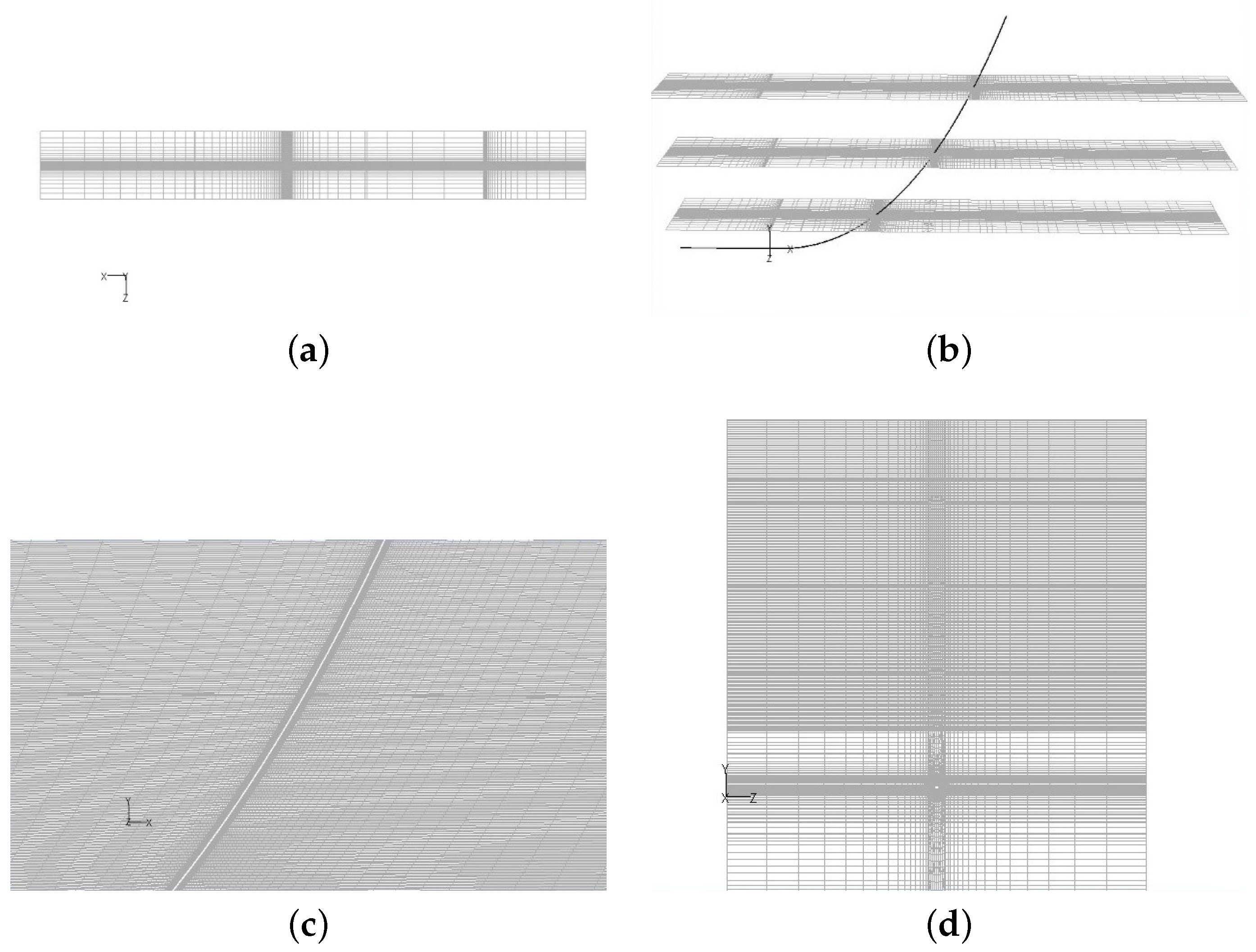

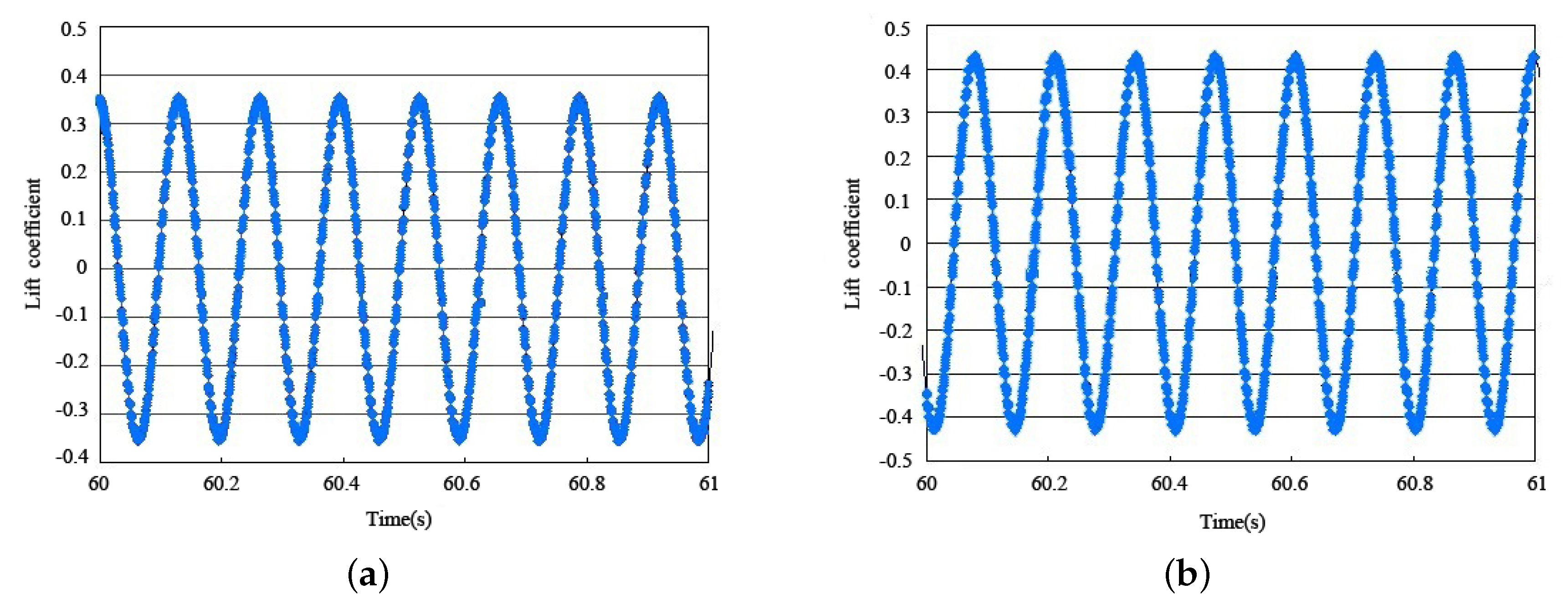
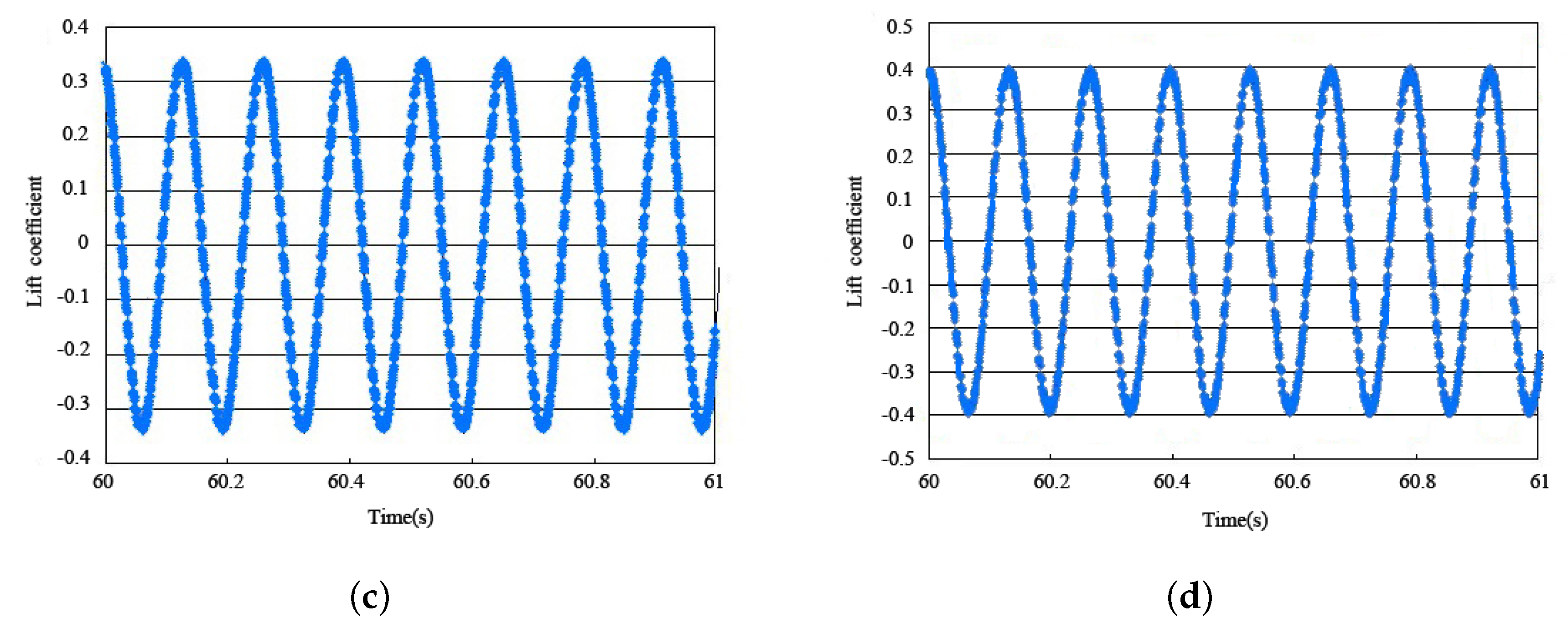
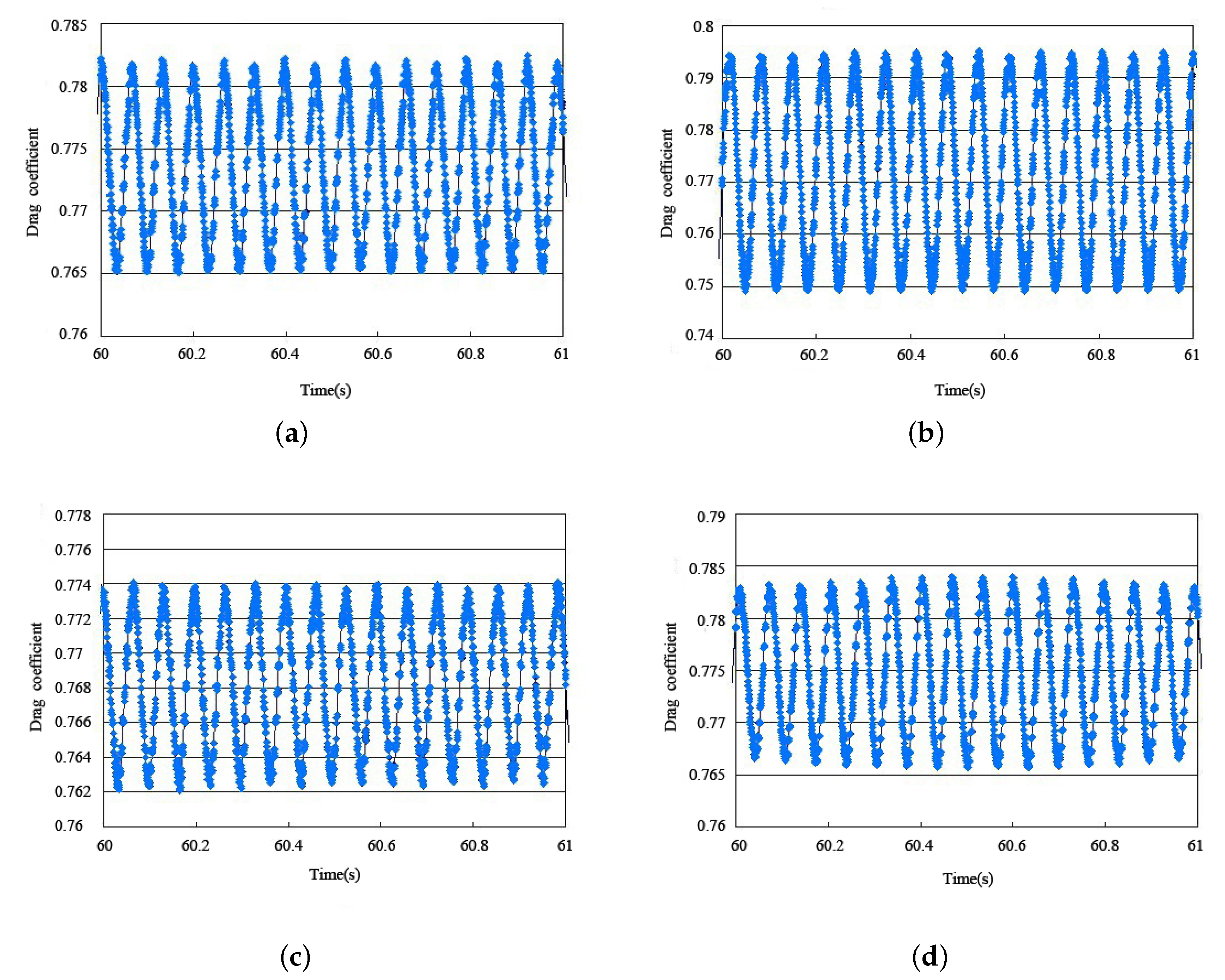


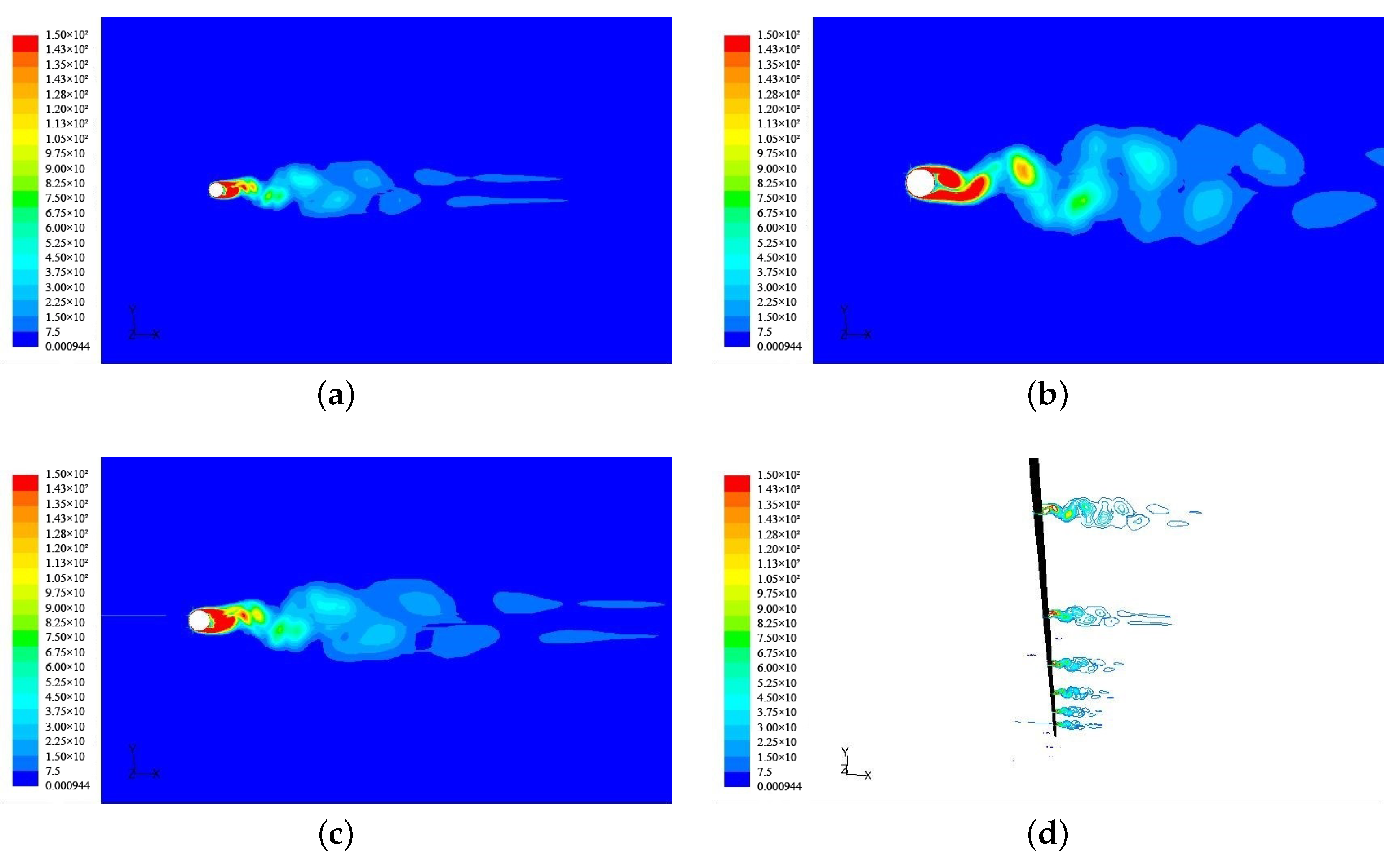




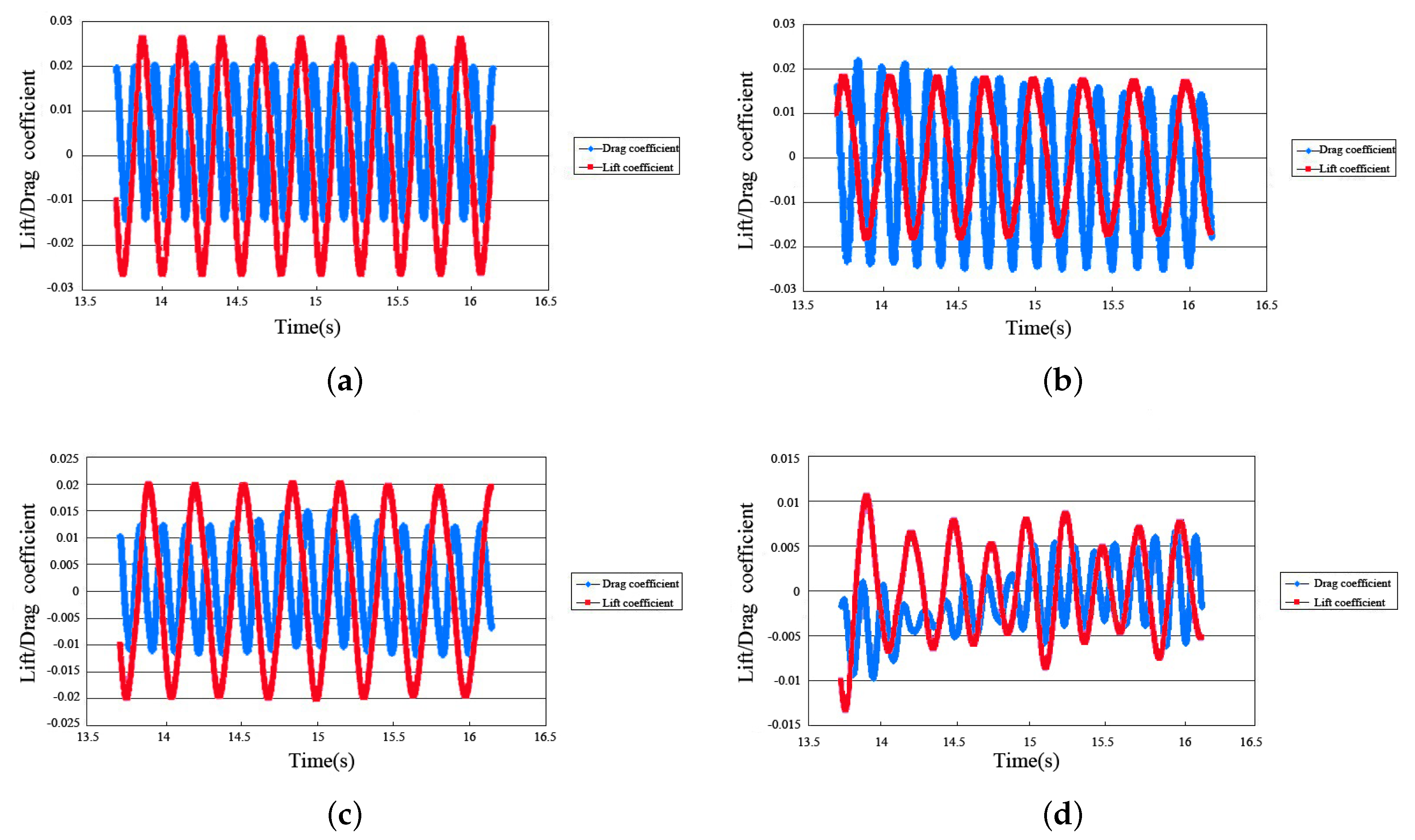


| Grid Number | Lift Coefficient | Lift Coefficient |
|---|---|---|
| 0.388 | 0.783 | |
| 0.385 | 0.782 | |
| 0.382 | 0.782 | |
| 0.382 | 0.782 | |
| 0.382 | 0.782 |
| Grid Number | Lift Coefficient | Lift Coefficient |
|---|---|---|
| 1.336 | 1.403 | |
| 1.334 | 1.402 | |
| 1.333 | 1.401 | |
| 1.332 | 1.401 | |
| 1.332 | 1.401 |
| Position | 1 m | 2 m | 3 m | Entire Riser |
|---|---|---|---|---|
| Lift coefficient period/(s) | 0.2544 | 0.3028 | 0.3223 | 0.2618 |
| Drag coefficient period/(s) | 0.1273 | 0.1522 | 0.1564 | 0.1377 |
Publisher’s Note: MDPI stays neutral with regard to jurisdictional claims in published maps and institutional affiliations. |
© 2022 by the authors. Licensee MDPI, Basel, Switzerland. This article is an open access article distributed under the terms and conditions of the Creative Commons Attribution (CC BY) license (https://creativecommons.org/licenses/by/4.0/).
Share and Cite
Wang, J.; He, Z.; Li, D.; Wu, W. Numerical Simulation of Vortex-Induced Vibration of TTR and SCR. J. Mar. Sci. Eng. 2022, 10, 708. https://doi.org/10.3390/jmse10050708
Wang J, He Z, Li D, Wu W. Numerical Simulation of Vortex-Induced Vibration of TTR and SCR. Journal of Marine Science and Engineering. 2022; 10(5):708. https://doi.org/10.3390/jmse10050708
Chicago/Turabian StyleWang, Jiachen, Zhilong He, Dantong Li, and Weifeng Wu. 2022. "Numerical Simulation of Vortex-Induced Vibration of TTR and SCR" Journal of Marine Science and Engineering 10, no. 5: 708. https://doi.org/10.3390/jmse10050708
APA StyleWang, J., He, Z., Li, D., & Wu, W. (2022). Numerical Simulation of Vortex-Induced Vibration of TTR and SCR. Journal of Marine Science and Engineering, 10(5), 708. https://doi.org/10.3390/jmse10050708






